Page 140 of 352 pages « First < 138 139 140 141 142 > Last »
Bill
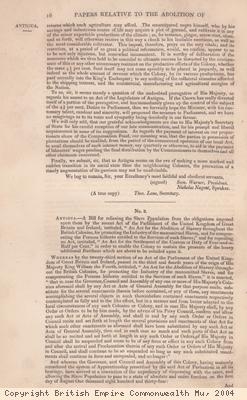
Description:
Proposed new law put to Antigua government for amending the Act for the Abolition of Slavery . The amendment allows immediate emancipation (freedom) for slaves on the Caribbean island of Antigua, without the usual period of apprenticeship. (Slaves who were later freed under the Emancipation Act, were then forced to work as apprentices). From Papers Relative to Abolition of Slavery, Part II, 1833-35.
Date: 1833-35
Copyright: Copyright British Empire Commonwealth Mu
Advertisement

Description:
Second page of advertisement for The Proceedings of the Governor and Assembly of Jamaica, in regard to the Maroon Negroes. (The word maroon means escaped slave and comes from a Spanish word meaning mountaineers. The slaves escaped from their plantations to the mountains and formed independant communities of free people.)
The language used to describe people of African descent in the 18th, 19th and 20th centuries is unacceptable in today’s terms. We cannot avoid using this language in its original context. To change the words would impose 20th century attitudes on history.
Date: unknown
Copyright: Copyright BCC Library Service
Object ID:BLS 326-1-05
French made gun adapted by owner
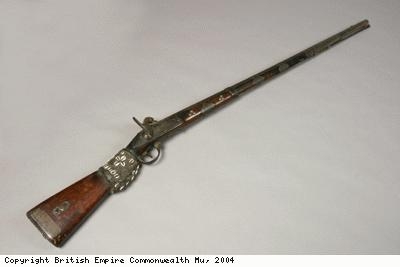
Description:
French-made percussion gun. The gun has been adapted, or customised, by its West African owner and decorated with a cloth band with cowrie shells sewn onto it.
Copyright: Copyright British Empire Commonwealth Mu
Object ID:1992/011/005
Progress regarding Maroons title page
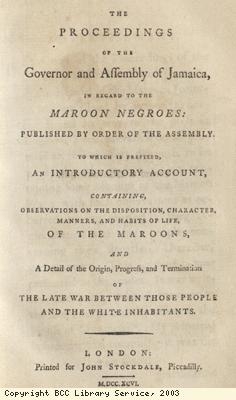
Description:
Title page of The Proceedings of the Governor and Assembly of Jamaica, in regard to the Maroon Negroes. (The word maroon means escaped slave and comes from a Spanish word meaning mountaineers. The slaves escaped from their plantations to the mountains and formed independant communities of free people.)
The language used to describe people of African descent in the 18th, 19th and 20th centuries is unacceptable in today’s terms. We cannot avoid using this language in its original context. To change the words would impose 20th century attitudes on history.
Date: 1837
Copyright: Copyright BCC Library Service
Object ID:BLS 326-1-03
British gun adapted by owner

Description:
British flintlock gun made by Thomas Barnett of London, who made trade guns, flintlock muskets and rifles. This gun does not have a proof mark, which is an official stamp to say that the barrel had passed a saftey test.Gun makers were known to dump their seconds on the export market and there is anecdotal information about guns exploding when used. The gun has been adapted, or customised,by its West African owner and decorated with cloth, leather fringe, cowrie shells, brass bands, beads and seed pods.
Copyright: Copyright British Empire Commonwealth Mu
Object ID:1992/011/003
Account of enslavement

Description:
An account of an enslaved African called Catsan of how he was enslaved, as told to a young boy in England. The family of the boy owned a plantation in Jamaica. Catsan had been taken to Guadaloupe, a French island in the Caribbean. He was then taken to France. Returning to Guadaloupe, he was shipwrecked off the English coast and earned a living as best he could.When he went blind, local people suported him with a cottage and some money to live on.
Page 24, taken from Memoirs of a West India Planter , by Rev john Riland, published by Hamittinb, Adams and Co. London, 1838.
Date: 1838
Copyright: Copyright BCC Library Service
Object ID:BLS 326-9279-24
Account of enslavement
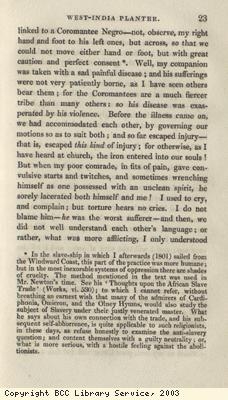
Description:
An account of an enslaved African called Catsan of how he was enslaved, as told to a young boy in England. The family of the boy owned a plantation in Jamaica. Catsan had been taken to Guadaloupe, a French island in the Caribbean. He was then taken to France. Returning to Guadaloupe, he was shipwrecked off the English coast and earned a living as best he could.When he went blind, local people suported him with a cottage and some money to live on.
Page 23, taken from Memoirs of a West India Planter , by Rev john Riland, published by Hamittinb, Adams and Co. London, 1838.
Date: 1838
Copyright: Copyright BCC Library Service
Object ID:BLS 326-9279-23
Account of enslavement
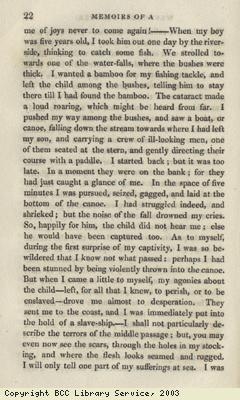
Description:
An account of an enslaved African called Catsan of how he was enslaved, as told to a young boy in England. The family of the boy owned a plantation in Jamaica. Catsan had been taken to Guadaloupe, a French island in the Caribbean. He was then taken to France. Returning to Guadaloupe, he was shipwrecked off the English coast and earned a living as best he could.When he went blind, local people suported him with a cottage and some money to live on.
Page 22, taken from Memoirs of a West India Planter , by Rev john Riland, published by Hamittinb, Adams and Co. London, 1838.
Date: 1838
Copyright: Copyright BCC Library Service
Object ID:BLS 326-9279-22
Account of enslavement
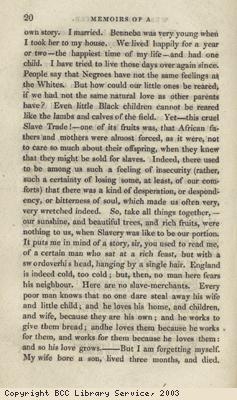
Description:
An account of an enslaved African called Catsan of how he was enslaved, as told to a young boy in England. The family of the boy owned a plantation in Jamaica. Catsan had been taken to Guadaloupe, a French island in the Caribbean. He was then taken to France. Returning to Guadaloupe, he was shipwrecked off the English coast and earned a living as best he could.When he went blind, local people suported him with a cottage and some money to live on.
Page 20, taken from Memoirs of a West India Planter , by Rev john Riland, published by Hamittinb, Adams and Co. London, 1838.
Date: 1838
Copyright: Copyright BCC Library Service
Object ID:BLS 326-9279-20
Account of enslavement
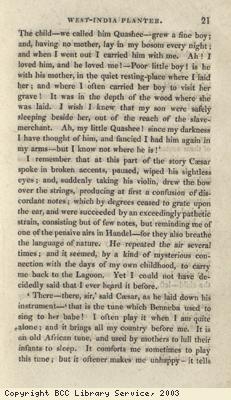
Description:
An account of an enslaved African called Catsan of how he was enslaved, as told to a young boy in England. The family of the boy owned a plantation in Jamaica. Catsan had been taken to Guadaloupe, a French island in the Caribbean. He was then taken to France. Returning to Guadaloupe, he was shipwrecked off the English coast and earned a living as best he could.When he went blind, local people suported him with a cottage and some money to live on.
Page 21, taken from Memoirs of a West India Planter , by Rev john Riland, published by Hamittinb, Adams and Co. London, 1838.
Date: 1838
Copyright: Copyright BCC Library Service
Object ID:BLS 326-9279-21
Page 140 of 352 pages « First < 138 139 140 141 142 > Last »

